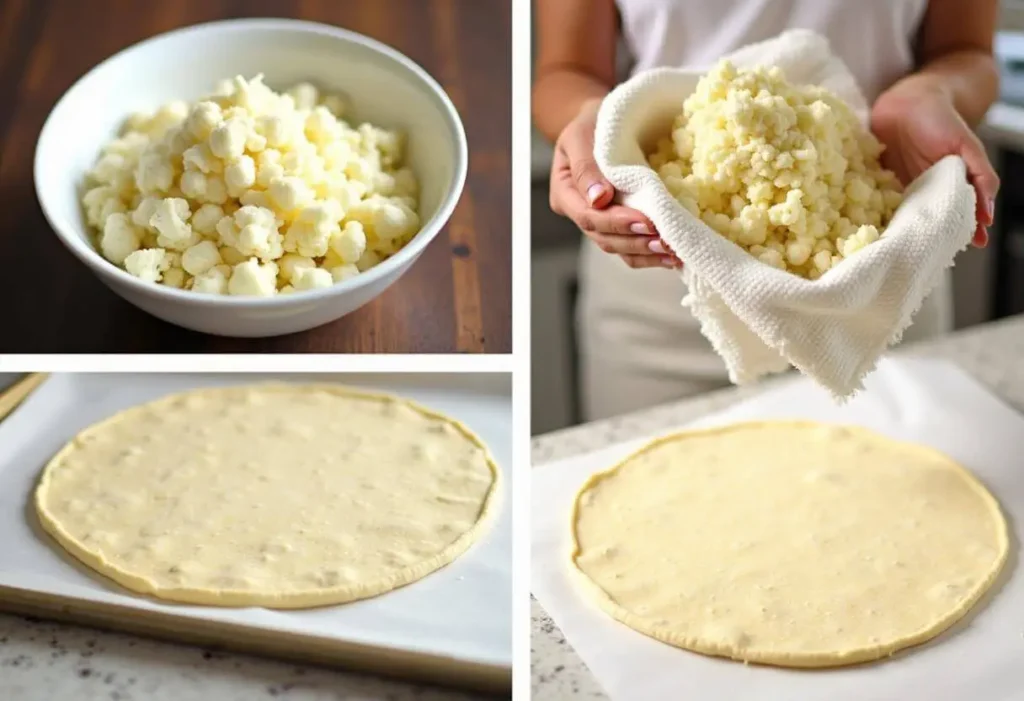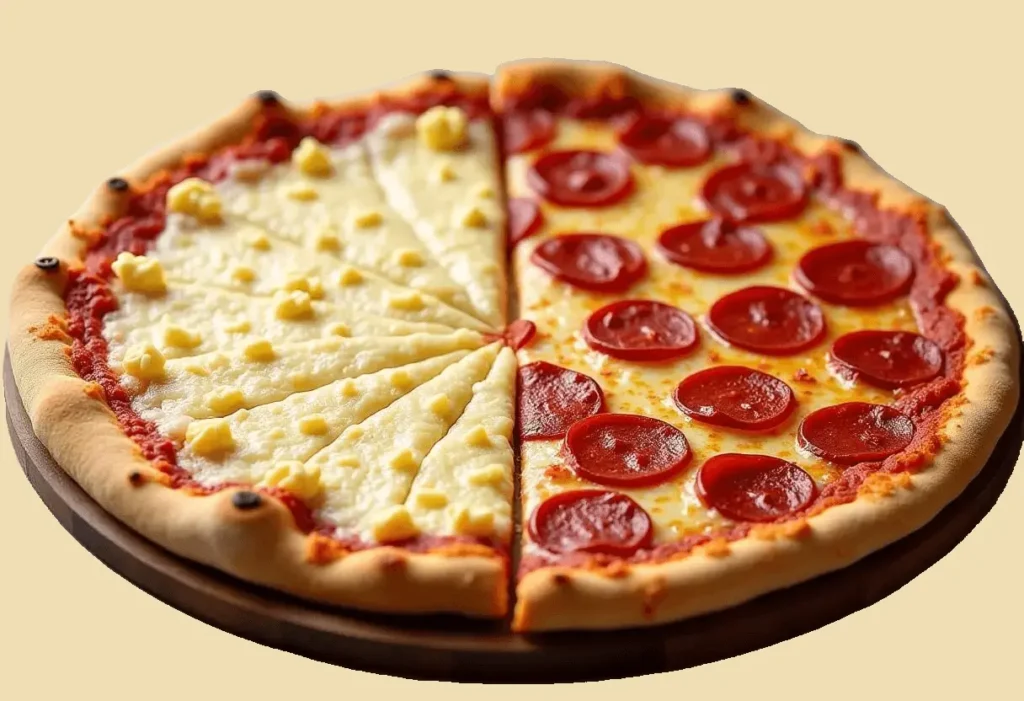Introduction
In recent years, cauliflower pizza crust has taken the culinary world by storm as a healthy alternative to traditional pizza crusts. Its growing popularity stems from its versatility and appeal to a wide audience, including health-conscious eaters, vegans, and those following low-carb or gluten-free diets. But what is cauliflower pizza crust made of? This unique crust is crafted primarily from cauliflower, combined with a few simple ingredients to bind and flavor it, making it both nutritious and delicious.

Cauliflower pizza crust is celebrated for its ability to mimic the texture of regular crust while drastically reducing carbs and calories. It’s perfect for anyone looking to enjoy pizza without compromising their dietary goals. Whether you prefer making your own crust at home or exploring pre-made options, this wholesome substitute has redefined how we think about pizza. Read on to learn all about its ingredients, benefits, and preparation methods.
What Is Cauliflower Pizza Crust Made Of?
Cauliflower pizza crust is a simple yet ingenious creation that has revolutionized healthy eating. Its primary ingredient is, of course, cauliflower, which is finely processed into a rice-like texture and cooked to remove excess moisture. But what does cauliflower pizza crust contain beyond its namesake vegetable? Typically, the base is mixed with binding agents and seasonings to hold its shape and enhance its flavor.
Base Ingredients
The essential components of cauliflower pizza crust include:
- Cauliflower: This serves as the main ingredient, providing a light, mild flavor and a nutrient-rich alternative to traditional flour.
- Binding Agents: Eggs are commonly used to hold the crust together. For a vegan-friendly version, alternatives like flaxseeds or chia seeds soaked in water can achieve a similar binding effect.
- Cheese (Optional): Some recipes incorporate grated cheese like mozzarella or parmesan for added flavor and structure. Vegan cheese can be substituted for plant-based diets.
- Seasonings: Garlic powder, Italian herbs, salt, and pepper add depth to the crust’s flavor profile.
Common Variations
- 3 Ingredient Cauliflower Pizza Crust: For a quick and simple version, this recipe requires just cauliflower, eggs, and a pinch of seasoning. It’s ideal for those who want to save time without compromising taste.
- Vegan Cauliflower Pizza Crust Recipe: Perfect for plant-based diets, this variation swaps eggs for vegan binding agents like aquafaba or a flaxseed slurry. Nutritional yeast can be added to mimic cheesy flavors.
- Gluten-Free Option: Since cauliflower is naturally gluten-free, this crust is an excellent choice for those with gluten sensitivities. Using almond flour or gluten-free breadcrumbs can further enhance the texture.
What Does Cauliflower Pizza Crust Contain?
Cauliflower pizza crust typically contains a blend of cauliflower, eggs or vegan substitutes, and seasonings, though variations abound depending on dietary preferences. Some recipes may include extras like cheese, almond flour, or additional herbs for a richer taste. The simplicity of the ingredients makes it a versatile choice, accommodating a wide range of dietary restrictions while delivering a delicious base for your favorite toppings.
With such flexibility, cauliflower pizza crust has become a household favorite for anyone looking to combine flavor and nutrition.
How to Make Cauliflower Pizza Crust
Classic Recipe
Creating a traditional cauliflower pizza crust at home is straightforward and rewarding. Follow these steps for a crispy, flavorful crust:
- Ingredients:
- 1 medium head of cauliflower (or 4 cups of riced cauliflower)
- 1 large egg
- ½ cup shredded mozzarella cheese (optional for richer flavor)
- ½ teaspoon garlic powder
- ½ teaspoon Italian seasoning
- Salt and pepper to taste

- Instructions:
- Prepare the Cauliflower: Wash and chop the cauliflower into florets. Pulse it in a food processor until it forms a rice-like consistency.
- Cook the Cauliflower: Microwave the riced cauliflower for 5–6 minutes or until soft. Let it cool, then squeeze out as much moisture as possible using a clean kitchen towel. This step is crucial for a crisp crust.
- Mix the Dough: In a bowl, combine the cooked cauliflower, egg, cheese, and seasonings. Mix until it forms a cohesive dough.
- Shape the Crust: Place the dough on a parchment-lined baking sheet. Flatten it into a thin, even circle or square.
- Bake: Preheat the oven to 425°F (220°C). Bake the crust for 20–25 minutes or until golden brown and firm.
- Tips for Perfect Texture and Crispness:
- Always squeeze out excess water from the cauliflower to prevent a soggy crust.
- For extra crispness, flip the crust halfway through baking.
- Use parchment paper to ensure easy removal.
To ensure your cauliflower crust has the perfect texture, it’s essential to properly rice and drain the vegetable. Learn how to properly rice cauliflower for cooking with these expert tips.
Quick and Easy Variations
For those short on time, there are faster methods to make cauliflower pizza crust without compromising on flavor or texture.
- Using Pre-Riced Cauliflower:
- Many grocery stores sell pre-riced cauliflower in fresh or frozen form. This saves time on chopping and processing.
- Simply cook the pre-riced cauliflower and proceed with mixing the dough.
- 3 Ingredient Cauliflower Pizza Crust:
- Combine cooked cauliflower, 1 large egg, and a pinch of salt. Optionally, add garlic powder for flavor.
- This minimalist recipe keeps things simple while delivering a delicious base for your toppings.
- Store-Bought Crust:
- For ultimate convenience, look for frozen or pre-made cauliflower pizza crusts at your local store. Brands like Cali’flour Foods and Trader Joe’s offer quality options.
This approach makes it easy to enjoy a healthy pizza crust without the effort of starting from scratch.
Vegan Adaptations
Making a vegan cauliflower pizza crust is just as simple with a few ingredient swaps. Here’s how:
- Replace Eggs with Vegan Alternatives:
- Flaxseed Egg: Mix 1 tablespoon of ground flaxseeds with 2.5 tablespoons of water. Let it sit for 5 minutes to form a gel-like consistency.
- Chia Egg: Follow the same process as the flaxseed egg, using chia seeds instead.
- Dairy-Free Binding Options:
- Use aquafaba (the liquid from canned chickpeas) as a binder. Whisk it until frothy for the best results.
- Incorporate 2–3 tablespoons of nutritional yeast for a cheesy flavor.
- Instructions:
- Follow the classic recipe, substituting eggs with your chosen vegan binder and cheese with vegan cheese or additional nutritional yeast.
- Tips for Vegan Crust Success:
- Ensure the cauliflower is thoroughly drained to maintain structure.
- Add a tablespoon of almond or oat flour if the dough feels too loose.
Vegan cauliflower pizza crusts are perfect for plant-based diets and packed with flavor.
To make your own plant-based pizza base, try experimenting with different binding agents or explore vegan-friendly pizza recipes for inspiration.
Health Benefits of Cauliflower Pizza Crust
Cauliflower pizza crust is often celebrated for its nutritional advantages over traditional pizza crusts. Whether you’re reducing carbs, avoiding gluten, or simply seeking healthier options, this alternative checks many boxes. Let’s dive into the key benefits and compare it to traditional crusts.
Nutritional Comparison: Cauliflower Crust vs. Traditional Crust
- Lower Carbs and Calories:
- Traditional pizza crust, typically made from refined wheat flour, is high in carbohydrates and calories. A single slice of regular pizza crust contains approximately 150–200 calories and 20–30 grams of carbs.
- In contrast, cauliflower pizza crust is much lower in both. A slice averages 50–70 calories and only 5–10 grams of carbs, making it an excellent option for low-carb and keto diets.
- Rich in Nutrients:
- Cauliflower is a powerhouse of vitamins and minerals, including Vitamin C, Vitamin K, and folate. It also contains antioxidants and fiber, promoting overall health.
- Traditional crusts lack these benefits due to the use of refined flour, which has minimal nutritional value.
- Gluten-Free:
- Cauliflower pizza crust is naturally gluten-free, making it a safe choice for those with celiac disease or gluten sensitivities.
- Gluten-containing pizza crusts can trigger digestive issues in sensitive individuals, whereas cauliflower crust offers a lighter and easier-to-digest alternative.

Cauliflower, as a cruciferous vegetable, is packed with vitamins, fiber, and antioxidants that promote overall health. To learn more, check out the nutritional benefits of cruciferous vegetables from the National Institutes of Health Source.
Is Cauliflower Crust Healthier Than Pizza Crust?
The short answer is yes, especially for those with specific dietary goals. Here’s why:
- Weight Management:
- With fewer calories and carbs, cauliflower crust supports weight loss or maintenance without sacrificing flavor.
- Traditional crusts, laden with empty calories, can contribute to weight gain when consumed in excess.
- Dietary Adaptability:
- Cauliflower crust caters to a wide range of diets, including gluten-free, paleo, keto, and plant-based.
- It allows more people to enjoy pizza without compromising their dietary restrictions.
- Improved Digestion:
- The high fiber content in cauliflower aids digestion, promoting a healthy gut. Traditional crusts, on the other hand, are often low in fiber and can lead to digestive discomfort.
For those curious about the specific nutritional benefits, this article helps to determine if cauliflower crust is truly the healthier choice compared to traditional and other alternative pizza crusts.”
Additional Health Benefits of Cauliflower Crust
- Low Glycemic Index: Cauliflower has a low glycemic index, meaning it doesn’t cause rapid blood sugar spikes like traditional flour-based crusts. This makes it ideal for diabetics or anyone managing blood sugar levels.
- Anti-Inflammatory Properties: The antioxidants in cauliflower can help reduce inflammation, which is linked to chronic diseases.
While cauliflower crust offers undeniable health benefits, it’s essential to read labels when purchasing pre-made versions. Some store-bought options include fillers or preservatives that may reduce their nutritional value. Opting for homemade or carefully chosen brands ensures you reap the maximum benefits.
Whether you’re prioritizing health, exploring dietary options, or just curious about this trending crust, cauliflower pizza crust provides a guilt-free way to enjoy pizza.
Where to Buy Cauliflower Pizza Crust
Frozen and Pre-Made Options
For those who want the convenience of a ready-to-use crust, frozen and pre-made cauliflower pizza crusts are widely available. These options save time and effort while still delivering a healthy, delicious base for your favorite toppings. Here are some popular brands to consider:
- Cali’flour Foods:
- Known for its high-quality frozen cauliflower pizza crusts, Cali’flour Foods offers both classic and plant-based options. Their products are gluten-free and keto-friendly, with minimal ingredients.
- Available online and at major grocery chains like Whole Foods and Sprouts.
- Green Giant:
- A budget-friendly option, Green Giant’s frozen cauliflower pizza crust is widely accessible. Their crusts are simple and versatile, perfect for any topping combination.
- Found in most supermarkets and big-box stores like Walmart.
- Trader Joe’s:
- Trader Joe’s offers an affordable frozen cauliflower pizza crust that’s gluten-free and easy to customize. It’s a fan favorite among health-conscious shoppers.
- Caulipower:
- As one of the leading brands, Caulipower provides frozen cauliflower crusts that are not only tasty but also nutritionally sound. They cater to gluten-free diets and are perfect for busy weeknights.
These frozen options are a fantastic solution for anyone short on time or new to cauliflower crusts. Look for them in the freezer section of your local grocery store.
Locating Vegan-Friendly Options
Finding vegan-specific cauliflower pizza crusts can be a bit more challenging, but there are excellent options available both online and in stores. If you’re wondering where to buy cauliflower pizza crust tailored to plant-based diets, here’s a guide:

- Whole Foods Market:
- Whole Foods carries a variety of vegan cauliflower crusts, including options from brands like Simple Mills and Whole Foods’ 365 label.
- Online Retailers:
- Websites like Amazon and Thrive Market offer a wide selection of vegan cauliflower pizza crusts. These platforms often provide detailed ingredient lists, making it easy to ensure the crust meets your dietary needs.
- Local Health Food Stores:
- Smaller health food stores frequently stock vegan cauliflower crusts from niche brands. Ask your local store for recommendations or check the freezer section.
- DIY Pre-Made Vegan Crust Kits:
- Some brands, such as Plant Power, sell pre-mixed cauliflower crust kits specifically designed for vegan diets. These kits are a convenient way to create your own crust with minimal effort.
- Farmers’ Markets and Specialty Shops:
- If you prefer supporting local businesses, check farmers’ markets or specialty vegan shops in your area. Many offer handmade cauliflower pizza crusts that cater to plant-based eaters.
By exploring these options, you can find vegan-friendly and frozen cauliflower pizza crusts that suit your lifestyle and preferences. Always read labels to ensure the product aligns with your dietary goals.
If you’re using store-bought or frozen options, understanding how to make cauliflower crust crispy can elevate your pizza-making experience.
Frequently Asked Questions (FAQs)
What Are the Ingredients in Pizza Pizza Cauliflower Crust?
Pizza Pizza, a popular pizza chain, offers a cauliflower crust that has captured the attention of health-conscious diners. Their cauliflower crust is made from a combination of ingredients designed to deliver flavor and structure while keeping it gluten-free.
Typical ingredients include:
- Cauliflower: The primary ingredient, providing a nutritious base.
- Rice Flour and Cornstarch: These gluten-free flours help create a firm texture and prevent the crust from falling apart.
- Cheese: Mozzarella and parmesan are often included for binding and taste.
- Egg Whites: Used as a binder to give the crust stability.
- Seasonings: Garlic powder, salt, and Italian herbs enhance the flavor.
While Pizza Pizza’s cauliflower crust is a healthier option than traditional dough, it’s important to note that it may not be suitable for strict keto or low-carb diets due to added starches. For a more personalized option, consider making your own cauliflower crust at home using whole, fresh ingredients.
What Is the Healthiest Pizza Crust?
Cauliflower crust is often celebrated as a top choice for its low-carb and gluten-free benefits, but is it truly the healthiest option? Other alternatives like almond flour, zucchini, or whole wheat crusts offer their own unique advantages and drawbacks.
Curious to learn which crust is the healthiest for your dietary needs? Find the complete breakdown here: What Is the Healthiest Pizza Crust?
Conclusion: Is Cauliflower Pizza Crust Worth Trying?
Cauliflower pizza crust has become a game-changer for those seeking healthier alternatives to traditional pizza. Its low-carb, gluten-free nature, combined with its versatility, makes it a standout choice for anyone pursuing a balanced diet. But beyond its health benefits, the question remains: What is cauliflower pizza crust made of, and why is it so popular? The answer lies in its simple yet nutritious ingredients, such as cauliflower, eggs or vegan substitutes, and flavorful seasonings, which come together to create a delicious and guilt-free pizza base.
Whether you’re drawn to its nutritional advantages, its adaptability to vegan or keto diets, or its ability to cater to gluten sensitivities, cauliflower crust offers something for everyone. From making a classic version at home to buying pre-made options, the possibilities are endless.
Why not give it a try? Experiment with homemade recipes or explore store-bought varieties to find your favorite. With cauliflower pizza crust, you can enjoy pizza night without compromising on taste or health.

